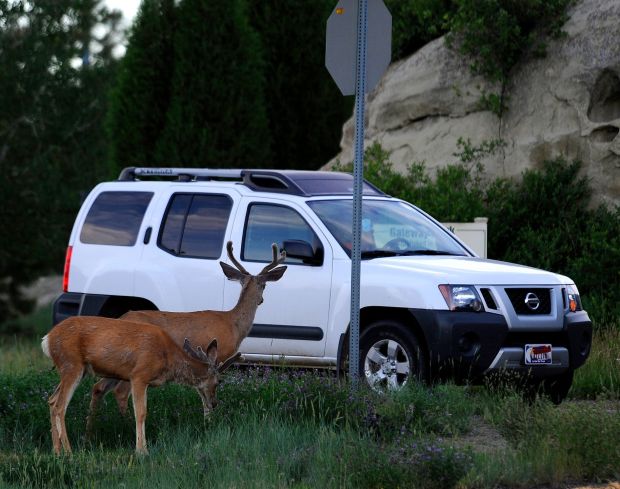
© Larry Mayer/Gazette StaffDinner?
Nearly a year after Montana initiated a method to legalize collection of roadkill, more than 800 permits have been issued.
"I'm elated," said Rep. Steve Lavin, R-Kalispell, who carried the bill in the last Legislature.
Lavin said his purpose behind supporting the bill was to
get meat into the freezers of people who could use it, so animals killed in collisions with vehicles wouldn't go to waste.
"I've heard a lot of positive comments about it," said Lavin, who is also a captain in the Montana Highway Patrol. He also endured a lot of jokes about the issue.
Painless permitsUnder the new law, free permits can be downloaded from the Montana Fish, Wildlife and Parks' website. They can also be issued by officers, such as the Montana Highway Patrol, who respond to wildlife-vehicle collisions.
"We've made it pretty painless for folks to get online and do this," said Jim Kropp, FWP's chief of law enforcement.
Although the agency had initially opposed the measure, Kropp said the program seems to be reasonably problem-free.
"There was a lot of concern at first about how we were going to get our arms around this," Kropp said. "We canvassed a lot of other states who had similar programs. No new programs are ever without problems, but we're happy with where we're at now."
Top dinersIn terms of the number of permits issued, Flathead County leads the state for the most roadkill permits at 135, followed by Lincoln with 92 and Missoula with 83. Gallatin County tallied 76, Ravalli had 72 and Lewis and Clark had 46. Yellowstone, the largest county by population in the state, saw 29 permits issued, Cascade had 24 and Carbon County recorded 11.
Kropp said it only makes sense that more of the collisions and collections take place in Western Montana where the majority of the state's people live - thus more traffic - and wildlife is plentiful in low-lying areas close to highways.
"There are a lot of animals that probably still aren't salvageable, but people are trying," Kropp said. "The damage may be more significant when people open them up."
Broken down by whether the animal was hit by the person who requested the permit or found the animal along the roadside, the numbers show about twice as many picked up from the road - accounting for more than half the permits - compared to those who were involved in a vehicle-wildlife collision.
Reflecting Montana's wildlife population,
the majority of the roadkill retrieved were whitetail deer - more than 550; followed by mule deer - nearly 150; elk - 120; and 33 moose.
Collision numbersMontana ranks third in the nation for wildlife-vehicle collisions, according to State Farm insurance. Drivers here have a one in 75 chance of hitting an animal. The top two states are out east: West Virginia leads with a one in 39 chance, followed by No. 2 Pennsylvania with a one in 71 chance.
State Farm calculated the average cost of a vehicle repair involved in a wildlife collision at more than $3,800. Montana and surrounding states are in one of the peak months for wildlife collisions because it is the deer breeding season. The rut drives deer, especially bucks, to move around more than usual, often at night.
Wyoming had considered a roadkill salvage bill during its last legislative session, but the measure didn't pass.
"I would be surprised if it doesn't come up again," said Brian Nesvik, chief game warden for the Wyoming Game and Fish Department.
One of the main reasons it was shot down is out of concern that poachers would purposely run over healthy animals just to claim them. That apprehension came up in Montana, as well.
"The potential for abuse is not unique to this program; it happens with wildlife in general," Kropp said.
Pmsl!!! Rofl!!! Dudes...youre smoking waaaay too much.